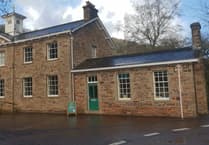THE annual gathering of Exmoor Ponies which roam free on Winsford Hill happened on Monday morning (October 20), one of the national park’s rare spectacles.
Each of the Exmoor Ponies on the moor is actually owned by somebody, and is not wild, as many people believe.
The Anchor herd lives wild and the ponies run on Winsford Hill and are gathered together each year using family and friends on horseback and quad bikes as part of an extraordinary annual ritual, and taken for inspection at the family farm.
The gatherings have an important purpose, allowing the crop of foals born in the spring to be separated from their mares and inspected one at a time by the Exmoor Pony Society.
They are then microchipped by a veterinary surgeon for identity, and the mares given a health check.
A detailed headcount is made, because even one colt foal being missed could have a significant breeding impact in the future.
The aim for the foals is to identify whether they are suitable to join the free-living herd or need be sold on for other purposes, such as future ridden ponies or into conservation grazing.
Foals which meet the breed standard can be entered in the Exmoor Pony studbook, which is maintained by the society.
The Anchor herd is owned by David and Emma Wallace.

Mr Wallace is a trustee and vice-chairman of the society, and the ponies have been under his family since 1947.
The herd was established in the 19th century and ponies first registered in 1921, the year in which the Exmoor Pony Society was established.
Exmoor Ponies are Britain’s oldest native breed, and while their numbers have grown steadily and they are carefully managed, they were once close to extinction.
Society chairman Nigel Hill said: “The Second World War had a huge impact on Exmoor ponies, and only 50 survived.
“This had an almost catastrophic effect on their bloodlines, with many being lost forever.
“This put the pony at risk, and even today it is a breed that is classed as ‘priority’ by the Rare Breeds Survival Trust, which essentially means endangered.
“This is where dedicated management of breeding and the stud book becomes so important.”
Today, more than 500 registered ponies in 21 free-living herds can be seen within the Exmoor National Park.
Exmoor National Park Authority itself owns a herd.
A further 3,500 registered ponies are located across the UK and abroad, both in domesticated and free-living environments.
Mr Hill said: “Owners and breeders need to manage how many foals are born, because there is a limited market for ponies, especially colts.
“It’ is a delicate balance, and we typically register fewer than 200 foals every year.
“When bloodstock and genetics is managed correctly, we will be able to preserve the genetic pool of the Exmoor Pony and increase its diversity.”
The gathering of ponies from the Anchor herd is one of several which will take place for the different herds on Exmoor during October.



